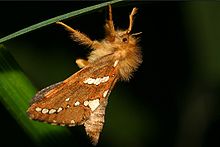Heather rootworm
| Heather rootworm | ||||||||||||
|---|---|---|---|---|---|---|---|---|---|---|---|---|

Heather rootworm ( Phymatopus hecta ) |
||||||||||||
| Systematics | ||||||||||||
|
||||||||||||
| Scientific name | ||||||||||||
| Phymatopus hecta | ||||||||||||
| ( Linnaeus , 1758) |
The heather rootworm ( Phymatopus hecta ) is a butterfly ( small butterfly ) from the family of the rootworm (Hepialidae).
features
The heather rootworm's wings are long and narrow and have a wingspan of around 23 to 30 millimeters. In the male , they are russet and patterned with silvery spots that are connected in rows. The wing color of the female is greyish in tone, the silvery spots are broadened. The wing tips have small hairs, the head area is surrounded by thick hair.
Way of life
At dusk, the males can be seen buzzing around helplessly, often in groups, looking for females. In doing so, they pull out a brush-shaped scent organ from the hind legs to attract females. In special cases this scent organ is also brought out while sitting. The females sit down on a plant near the male to mate and the male comes over to fly. The whitish eggs are laid on the ground, they are simply dropped by the female in flight near the caterpillar fodder plant.
In the course of autumn the caterpillars hatch from their eggs . They hide immediately in the ground and feed externally on the roots of the bracken Pteridium aquilinum (possibly also on other plants, but the information on this is uncertain). They hibernate in the ground and in the following spring they dig into the base of the stem, where they eat an oval cavity, before they leave the plant in spring and pupate in the ground . The moth flies from June to the end of August.
Since the moths only have stunted mouthparts, they cannot ingest food.
habitat
The moth can be found in both lower and higher altitudes. Its typical habitats are forest meadows , forest edges and grassy heaths . It is widespread throughout the European Union and into western Russia . The type is common.
swell
Individual evidence
- ↑ Norges Sommerfugler / Phymatopus hecta (Norwegian) ( Memento from February 29, 2008 in the Internet Archive )
- ↑ Heiko Bellmann: Steinbach's natural guide , butterflies , Ulmer, Stuttgart (Hohenheim), 2010, ISBN 978-3-8001-4653-6
- ↑ Phymatopus hecta in Lepidoptera of Belgium ( Memento of the original from May 13, 2007 in the Internet Archive ) Info: The archive link was automatically inserted and not yet checked. Please check the original and archive link according to the instructions and then remove this notice.
- ↑ JR Grehan (1989): Larval feeding habits of the Hepialidae (Lepidoptera). Journal of Natural History 23: 803-824
- ↑ Lepidoptera and some other life forms / Phymatopus hecta (English)
literature
- Jozef Ponec: Butterflies of our homeland . Verlag Obzor, Bratislava (German translation of the original Slovak edition from 1982) ISBN 3-8112-0380-0
- Heiko Bellmann: Steinbach's natural guide , butterflies , Ulmer, Stuttgart (Hohenheim), 2010, ISBN 978-3-8001-4653-6
Web links
- Moths and Butterflies of Europe / Phymatopus hecta
- Phymatopus hecta near Fauna Europaea. Retrieved February 27, 2011
- British butterflies: Gold swift
